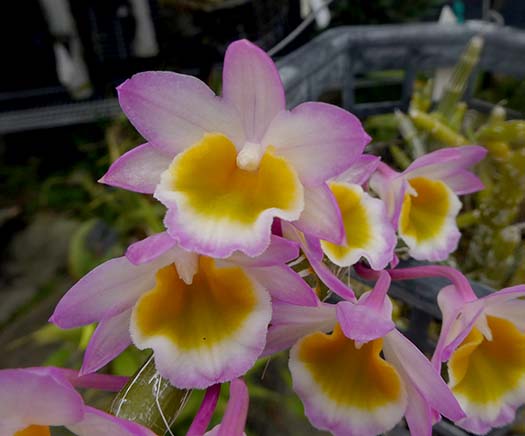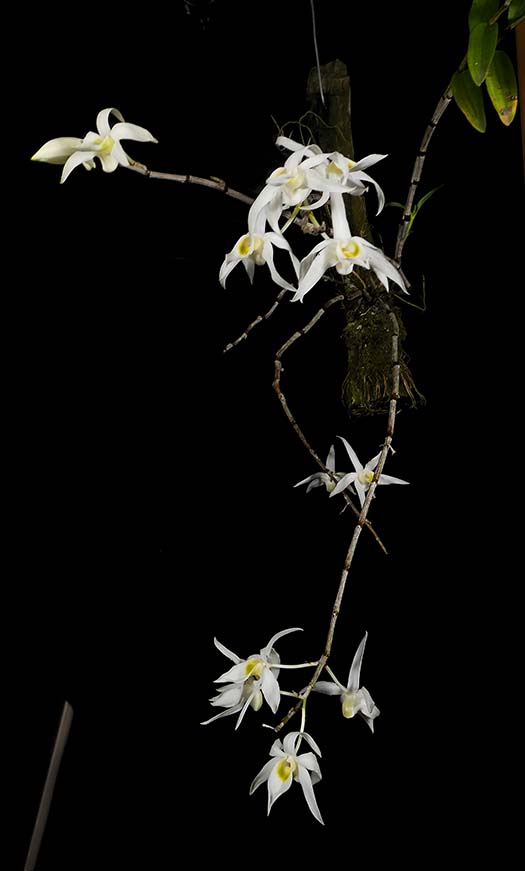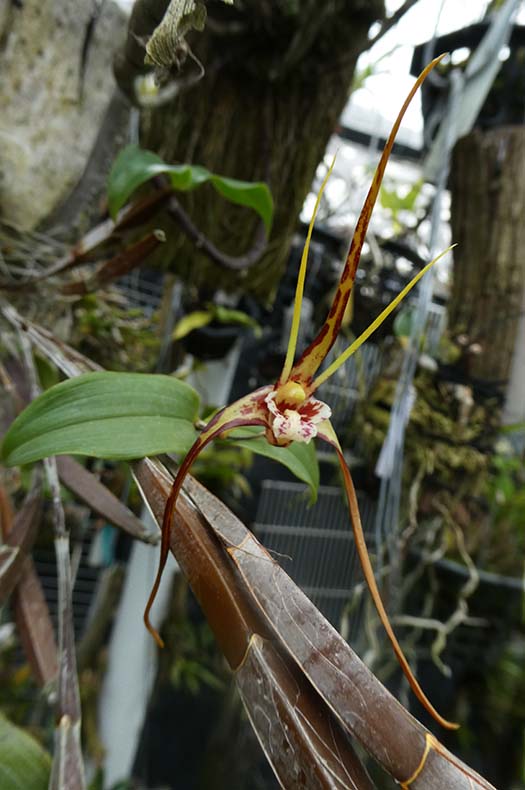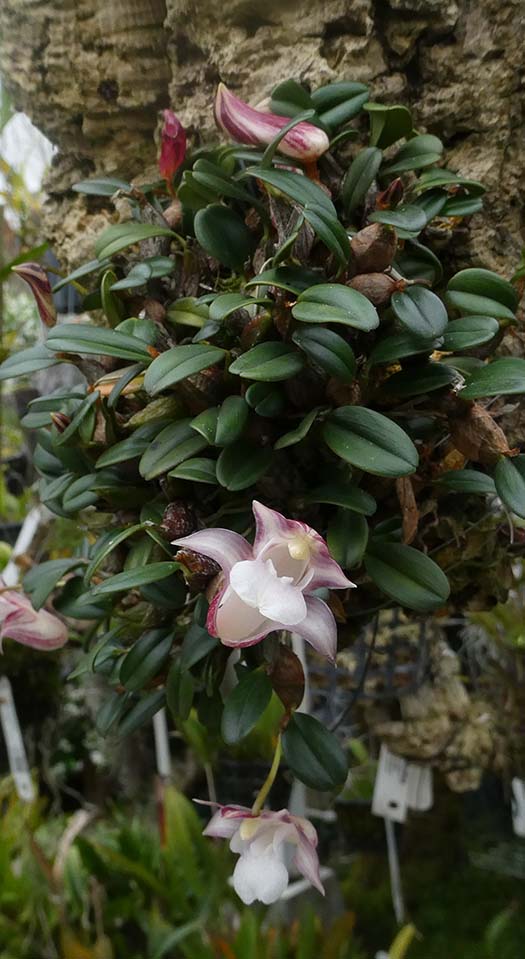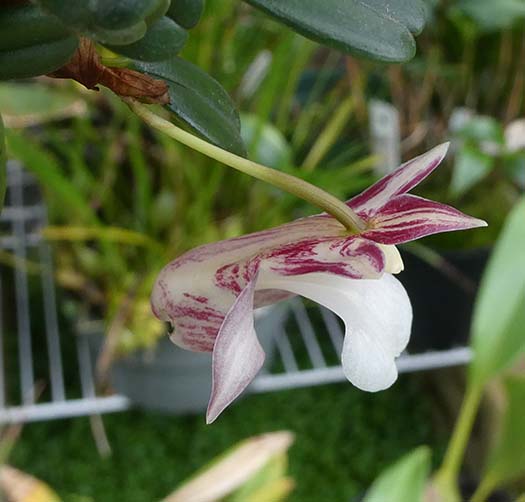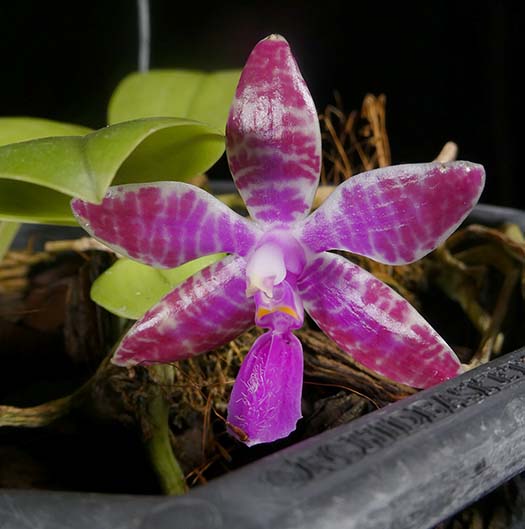July 2023
From Kurt Shanebeck:
|
|
Outdoors coastal, north of Los Angeles: |
|

Masdevallia veitchianaNative to high elevations in Peru. After suffering a near-death experience in last years heat wave plant seem to be recovering. Growing potted in bark with bright light. |
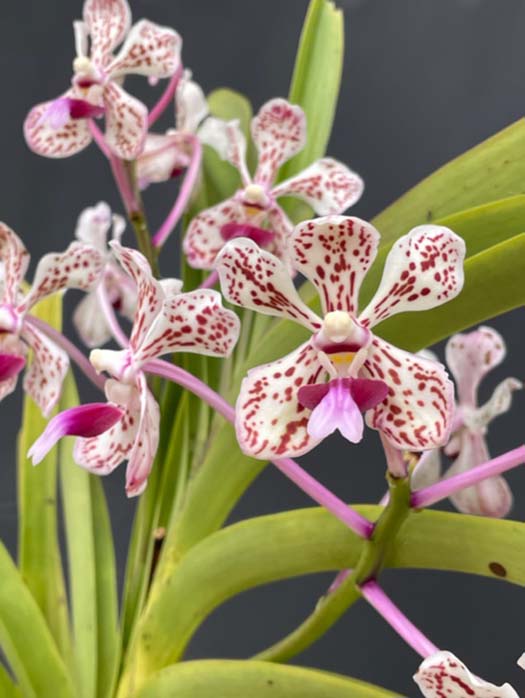
Vanda tricolorNative to Java. Potted in bark and given bright light. |
From Chris Ehrler:
|
|
Coastal, California Central Coast |
|
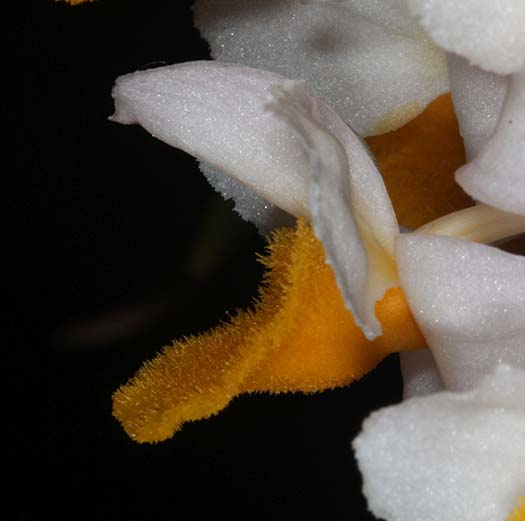
Dendrobium thyrsiflorumNative to the Chinese Himalayas, Hainan China, Assam India, eastern Himalayas, Myanmar, Thailand, Laos, and Vietnam at elevations of 1200 to 2000 meters. Is a cool growing epiphyte, lithophyte, or terrestrial species. This orchid is growing in a plastic pot filled with bark and lava rock with the pot being placed outside under a wood lath cover. For unknown reasons this year this orchid only produced one spike in June while last year it produced four spikes in March. |
|
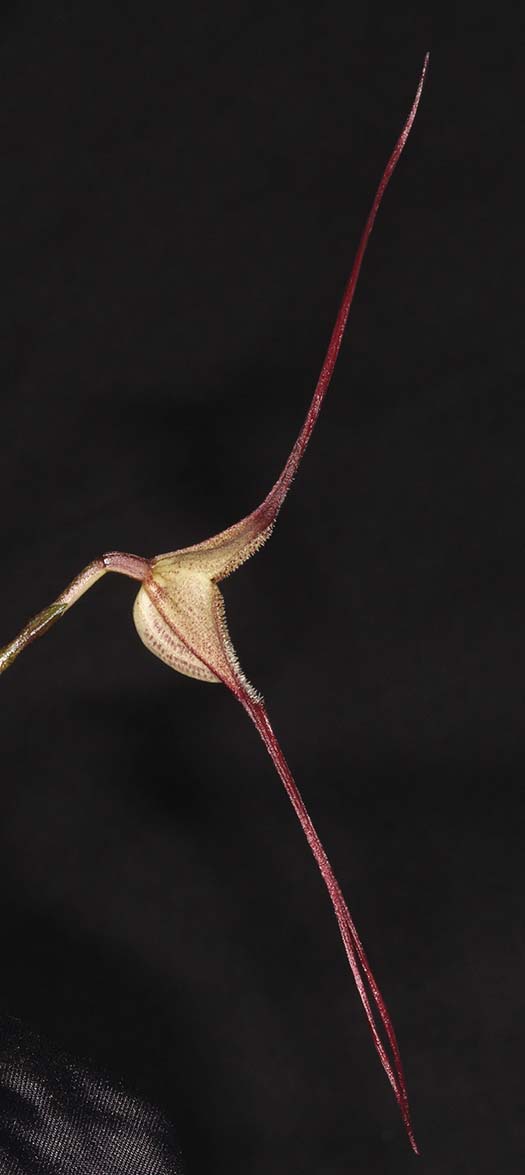
Dracula barrowii 'Kathy' AM/AOSA cool to cold growing epiphyte which was grown and described from a plant in England that came from Peru, although this species has not been found again in Peru. This orchid is growing in a cool greenhouse in a mesh pot filled with sphagnum moss. |
|
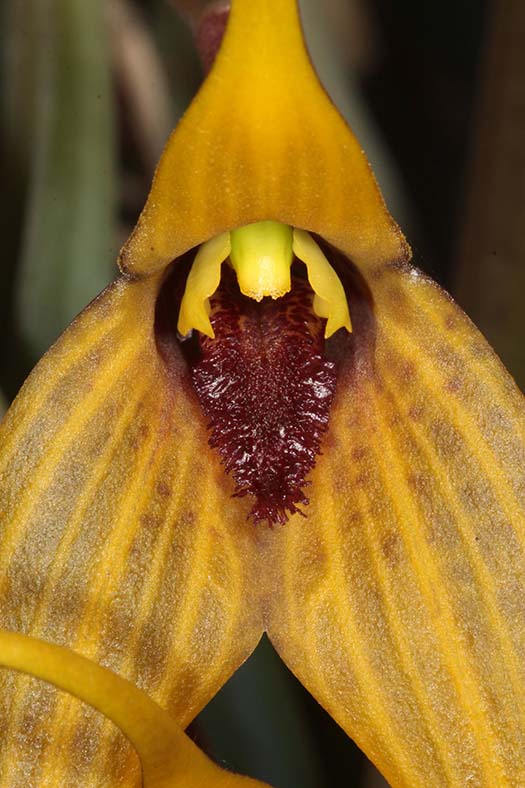 Masdevallia caesiaA cool to cold growing species found in southwestern Colombia in cloud forests at elevations of 1600 to 2200 meters. It is a pendant species which produces flowers with an odd odor. Generally it blooms in March but it is blooming in June this year. Grows in a mesh pot filled with sphagnum moss that is hung outside under a wood lath cover. |
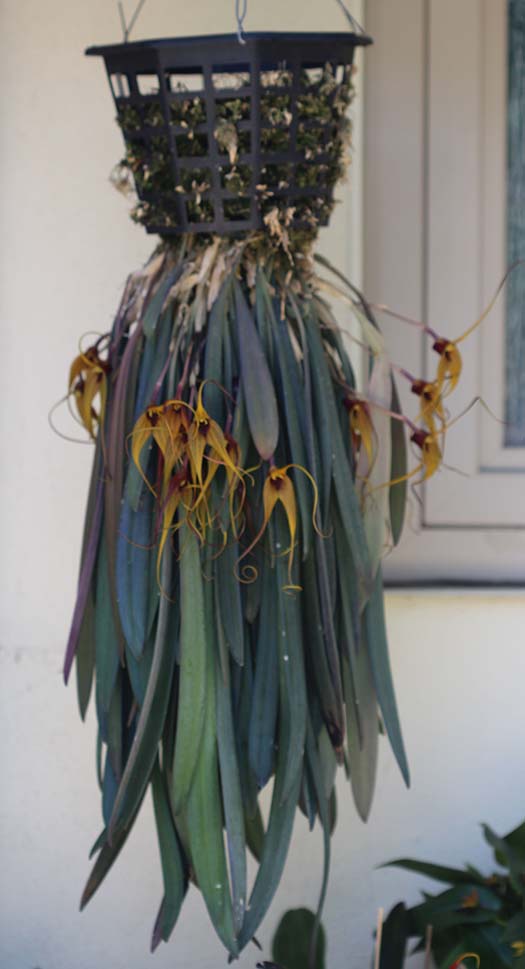 |
 Masdevallia caudataA cool to cold growing epiphyte found in Colombia and western Venezuela at altitudes of 1800 to 3300 meters. This orchid is growing in a cool greenhouse in a clay pot filled with sphagnum moss. |
|

Masdevallia lappiferaA cool growing epiphyte found at an elevation of 1,200 meters in Ecuador. This orchid is growing in a cool greenhouse in a clay pot filled with sphagnum moss. |
|
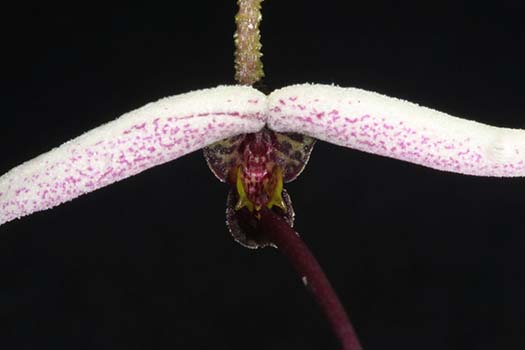
Scaphosepalum gibberosaA cool growing epiphyte found at elevations of 1600 to 2000 meters in Colombia. This orchid is growing mounted on a piece of wood with some sphagnum moss over the roots. The mount is hanging in a cool greenhouse. |
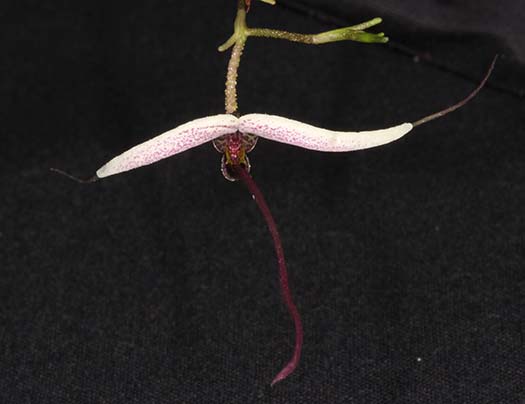 |
From James Lockman:
|
|
All plants grown outside, inland San Diego County, on a protected patio with 40% shade or more.
|
|
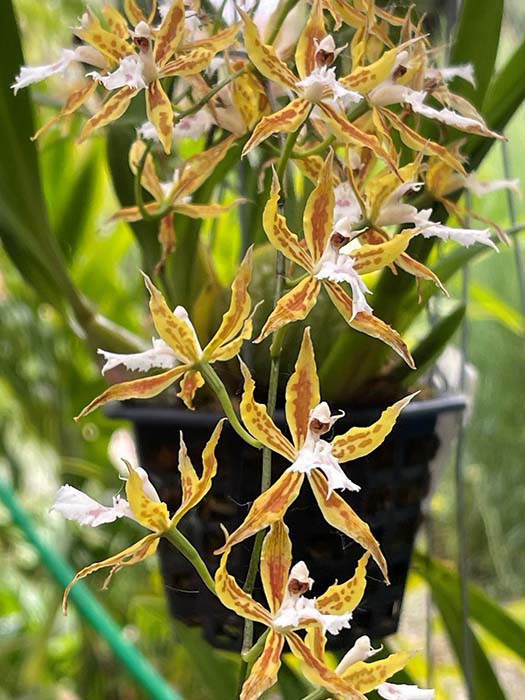 Oncidium (Odontoglossum) constrictum |
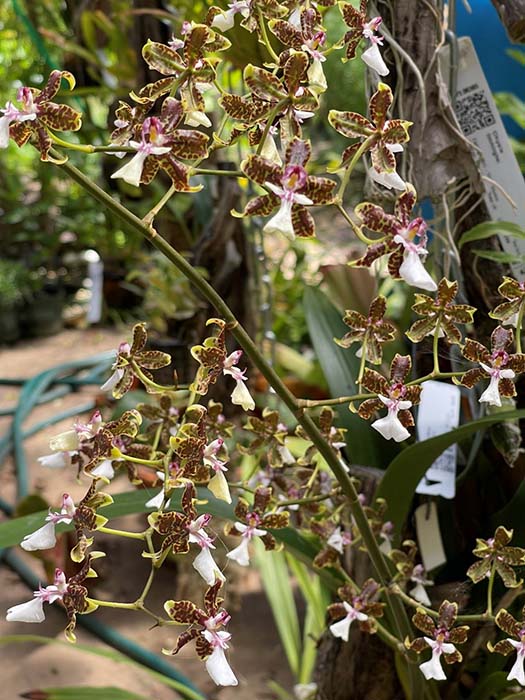 Oncidium leucochilum |
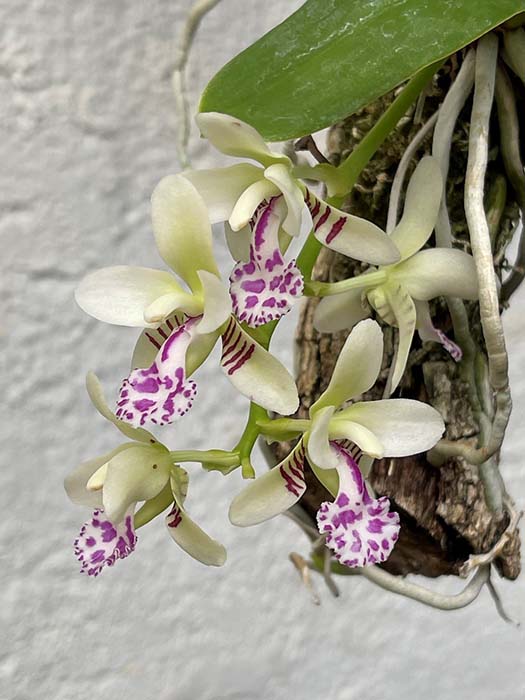 Phalaenopsis (Sedirea) japonica |
|
From Scott McGregor:All orchids grown outdoors, coastal southern California |
|
Capenemia uliginosa/superfluaPuchased as Capenemia uliginosa, some say it is synonymous with C. superflua. I really like the tiny fragrant crystalline flowers but can be a bit tricky to keep happy. Best grown as a “twig epiphyte”; i.e. mounted, bright, watered frequently but allowed to dry between waterings. |
|
 |
|
Angraecum urschianumTiny but cute Angraecum from Madagascar that has a fantastic flower to plant size ratio. Thought I brushed off all the aphids but, oh well… |
|
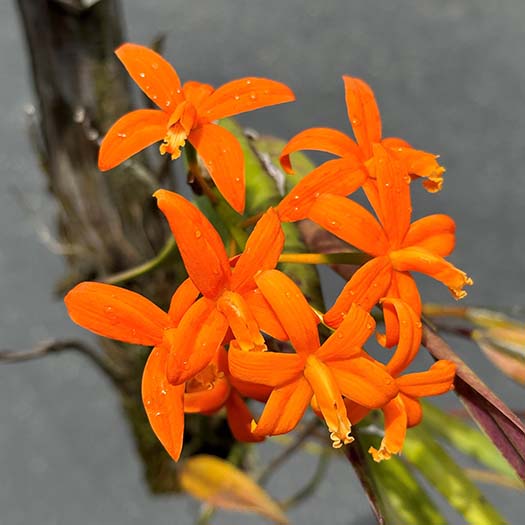
Cattleya (Laelia) harpophyllaOrange!!! |
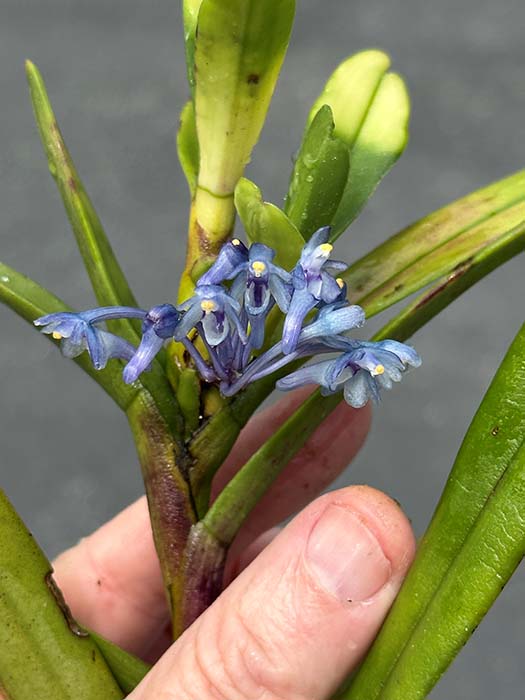
Cleisocentrum speciesA very blue unidentified species (not gokusingii or merrillianum) of this vandaceous genus. Our cool Spring weather has contributed to the deeper color this year. |

Dendrobium hancockiiGraceful and fragrant, with 2” yellow flowers on thin arching bamboo-like canes. Sadly, my veiled chameleon “Jeffrey” passed away earlier this year, but the good news is that I now get to enjoy the flowers of this species. Jeffrey would systematically devour every D. hancockii bud just before it opened. Not sure why he was uniquely attracted to this species. |
 |
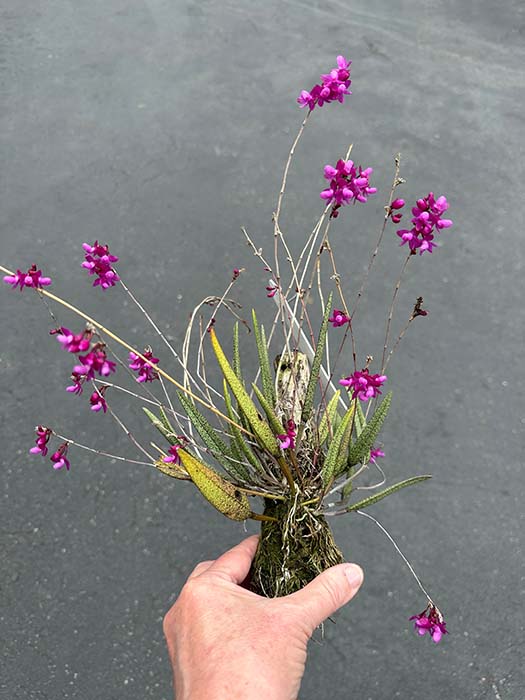
Domingoa (Nageliella) angustifoliaA fun, easy grower, that re-blooms on old flower spikes (don’t cut them!). Tiny flowers, but cheerful and blooms over a long time period. |

Epidendrum lacustre
|
 |
Leptotes bicolorThis is a so-so clone of the typical L. bicolor—the 4N varieties are much prettier with larger and better structured flowers. This species is unusual in that it shares seed pod chemistry with Vanilla, so you can pollinate this for your own tiny “vanilla beans”. |
 |
|
Pholidota chinensisFragrant flowers on pendant spikes that first open at the end of the spike. Easy grower (and quickly needs to be divided/repotted). |
|
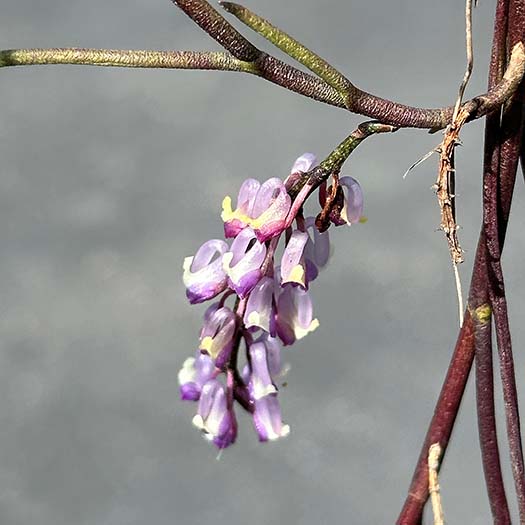
Schoenorchis juncifoliaA graceful vandaceous species from Borneo with wisteria-like hanging flowers. A large plant almost always has a flower spike or two in bloom. |
 |
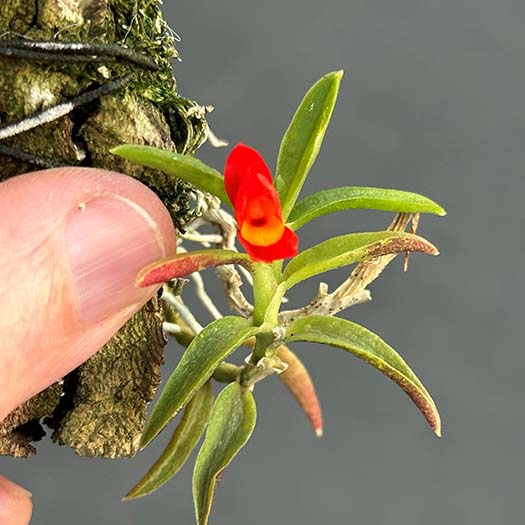
Fernandezia maculataA fussy and challenging twig epiphyte that best grows mounted, breezy and bright. Really pretty red/orange/yellow flowers, although quite a mini. |
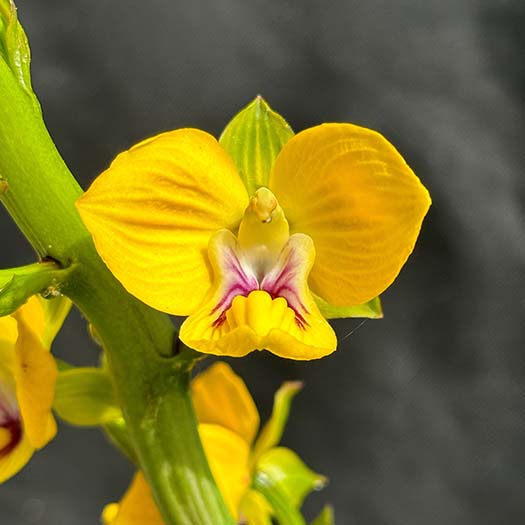
Eulophia speciosaThis is a fabulous species for outdoor growing here in Southern CA (thanks, Roberta!). It is happy in a pot of sand and some direct sunlight. The spikes are just starting to open sequentially and will remain in bloom for many months. |
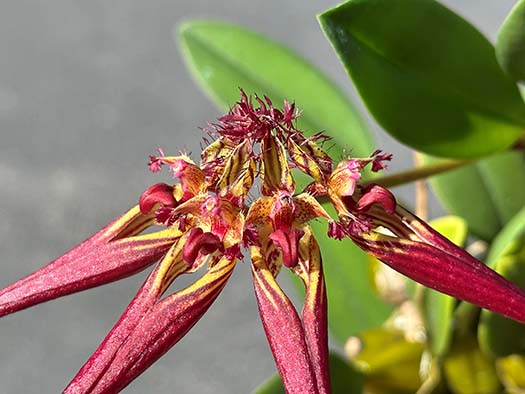
Bulbophyllum wendlandianumThis is one of my favorite Bulbophyllums. It happily grows and flowers outdoors, branches but stays compact as it covers its mount, it is floriferous, and best of all—the flowers are fantastically colored and shaped with appendages dangling and fluttering in the breeze. |
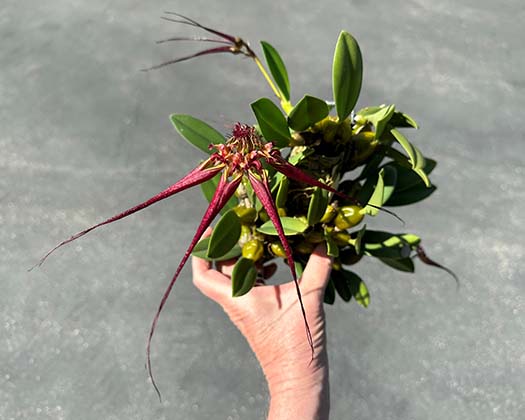 |
Diplocaulobiums - Watermelon Day!Diplocaulobium arachnoides on the left and D. aratiferum ‘Watermelon Rind” on the right. Both smell intensely of watermelon. Interesting combination with the coconut from my Maxillaria tenuifolia which is also in bloom. |
|
From Roberta Fox:
|
|
Outside in the Back Yard: |
|

Angraecum equitansNative to Madagascar, at elevations up to around 2000 m. Flower is quite large relative to the plant. |
|
 Angraecum germinyanumNative to Madagascar, from the central plateau region, elevations 900-1500 m. This area can get down to near freezing in winter. This plant is very vigorous, having several growths extending far outside its basket with roots in the air. These are the growths that produce the flowers, which float freely. |
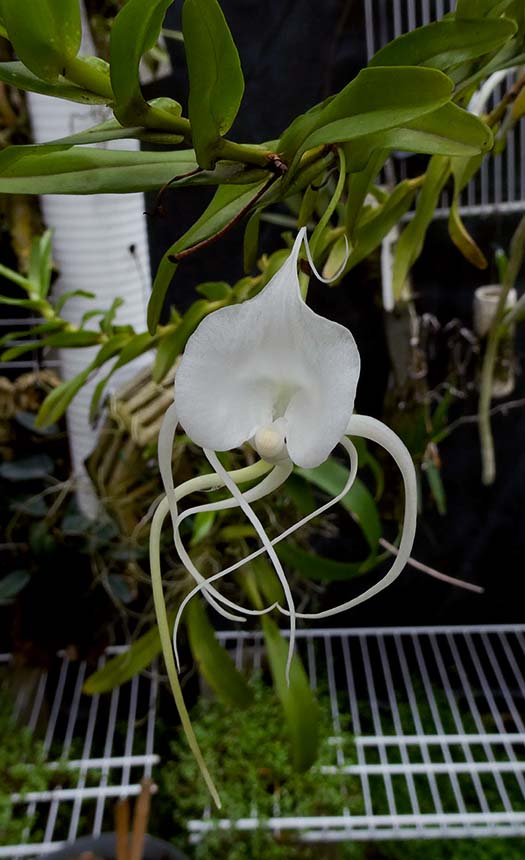 |
 |
|
Warczewiczella (Cochleanthes) discolorNative to Central America and northern South America. Typical elevations 1200-1850 m, but can grow as high as 2300 m. |
|
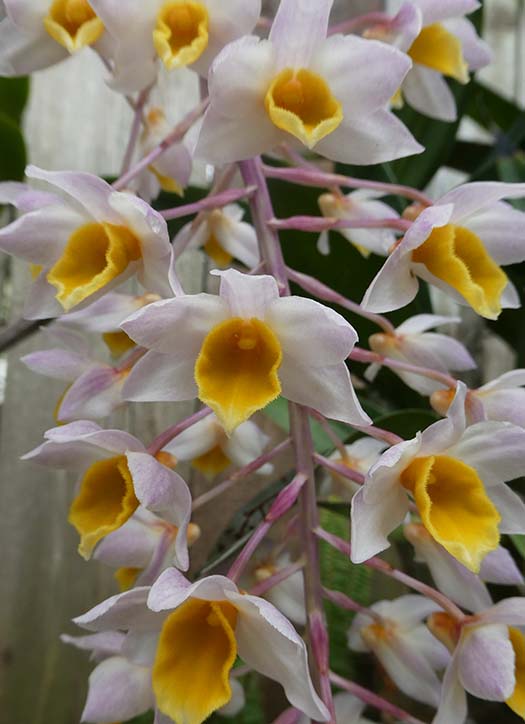 Dendrobium thyrsiflorum or amabile or ??Label says Den. thyrsiflorum but everything that I can find about that one is that the segments are white or cream. The segments on this one are uniformly pale pink - appear much more pink to the eye than the photo shows. Both species produce the inflorescence quite rapidly, it appears almost from nowhere, then it quickly elongates and blooms. |
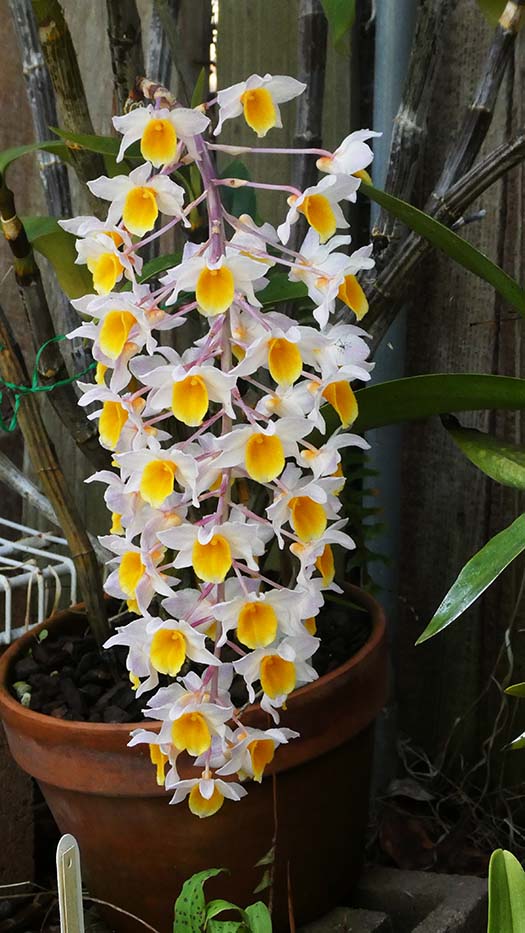 |
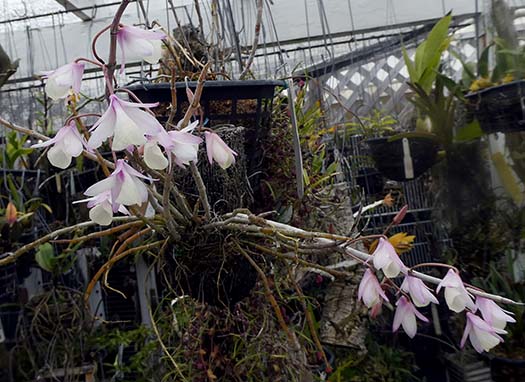 Den. aphyllum var. latifolium (Den. pierardii)Delicate flowers emerge from leafless canes. (New growth just starting to emerge.) As I mentioned last month, I don't keep my deciduous Dendrobiums dry in winter (this year they got rained on a LOT), and they bloom anyway. Winter cold seems to be all the trigger that they need. This one is found over a wide area of southeast Asia and southern China, elevations 1000-1800 m. |
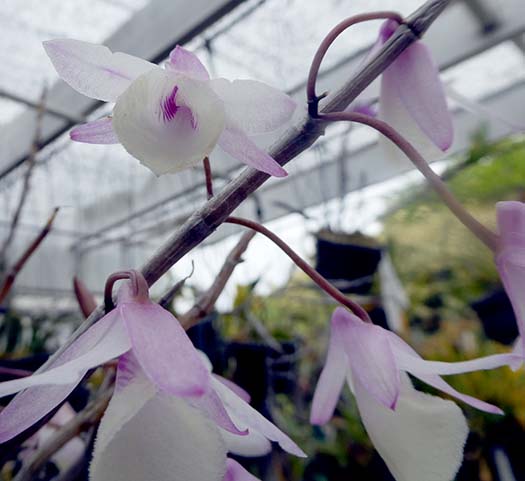 |
 Dendrobium crepidatumHimalaya, southeast Asia, Yunnan province of China, elevations to 2100 m. |
|
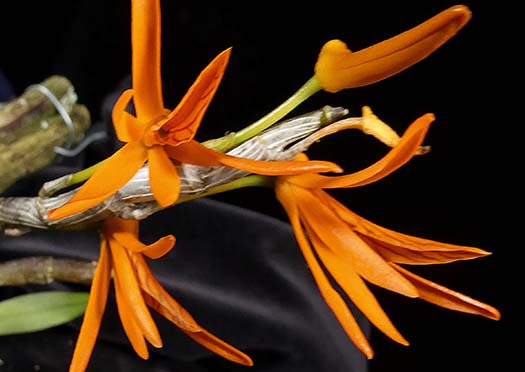 Dendrobium dickasoniiSame geographical range... brilliant flowers appearing from dead-looking canes. |
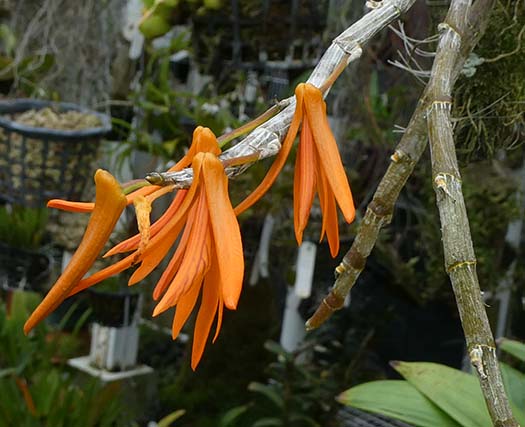 |
 Dendrobium wilsoniiSouthern and south-central China. There are so many beautiful species of deciduous, high-elevation cool-growing Dendrobiums, which grow very well in southern California. |
|
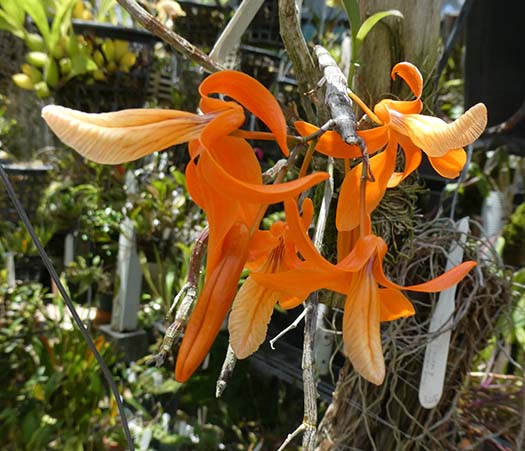
Dendrobium unicumNorthern southeast Asia, elevations 1000-1500 m. |
 |
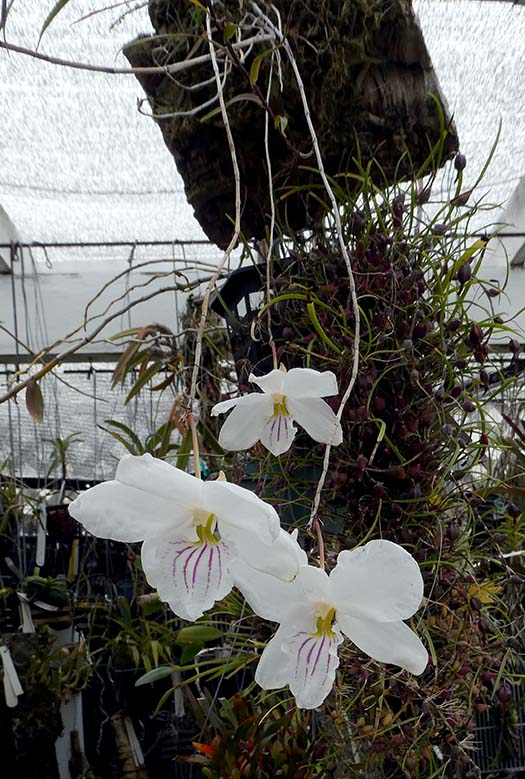 |
|
Dendrobium papilio (large flower form)Native to the Philippines, elevations 1400-2200 m. Scott showed you a beautiful blooming of these last month. As he noted, this form tends to be less floriferous than the smaller flower form, but this year I also got multiple flowers when it first bloomed. Now, I'm getting them one at a time, but extending the bloom time. These are nearly 4 inches. They float on thin, flexible, leafless canes. Like their namsake, the butterfly. |
|
 Dracula benedictiiFrom Colombia. Small, long lasting flowers emerging all around the base of the plant. They don't collapse in the heat of the day the way the larger ones do. Some flowers emerge from side of the basket but most are at the top. |
|
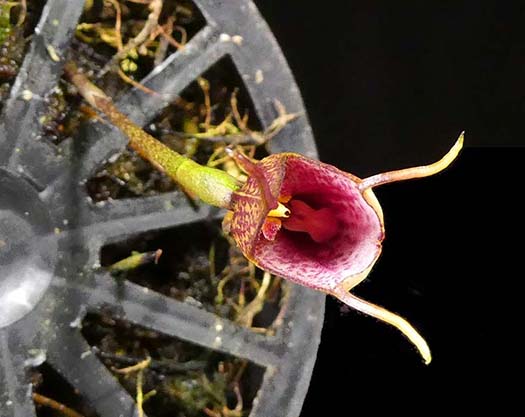 Dracula venosaNative to Colombia and Ecuador. First time this one has bloomed for me. |
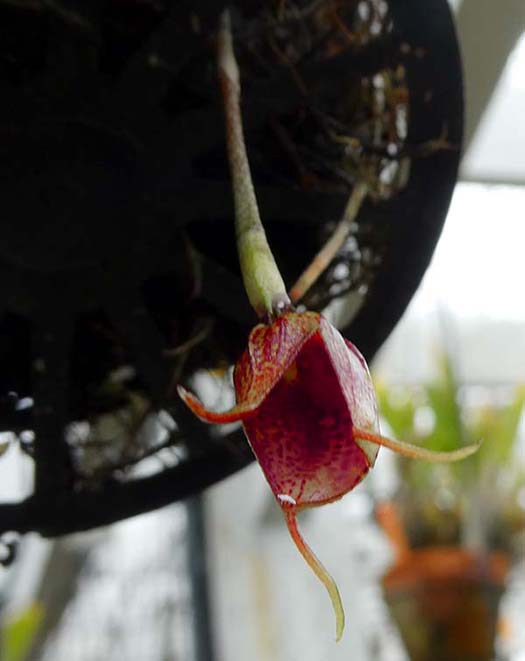 |
 Prosthechea (Encyclia) vitellinaNative to Central America and southern Mexico, elevation 1400-2600 m. It grows well near the coast, but probably would have problems with heat farther inland. In habitat, it experiences summer days in the low 70's F, with nights around 50, cooler in winter. Clearly it has adapted to temperatures that are somewhat warmer. It can continue to open flowers over several months, with the inflorescence continuing to elongate. Last year, by the time it finished blooming at the end of September, the inflorescence was about 18 inches long. |
|
 |
|
Encyclia maculosa (Prosthechea guttata)Native to southern Mexico. It continues to produce these odd spiky little flowers sequentially for most of the year, being out of bloom for only 2 or 3 months in winter. |
|
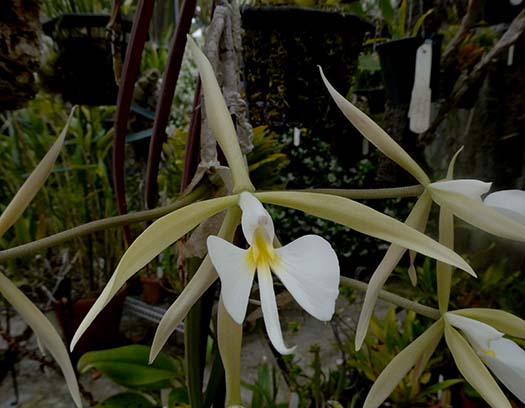 |
|
Epidendrum parkinsonianumNative to southern Mexico and Central America. Flowers are night-fragrant. This species needs to be grown mounted, since the flexible growths, with their heavy, succulent leaves hang downward. |
|
 Epidendrum falcatumClosely related to Epi. parkinsonianum, mostly growing in southern Mexico. Leaves hang downward, but are not as long as those of Epi. parkinsonianum, and are just as likely to grow sideways as downward. The growths are extremely brittle, breaking off with only a light touch. This makes growing a large plant difficult to impossible, but the broken-off growths root easily. I try not to move it, but sometimes it still gets bumped when I move the plant next to it, and I end up with more bits. This is probably one of the ways that it propagates. |
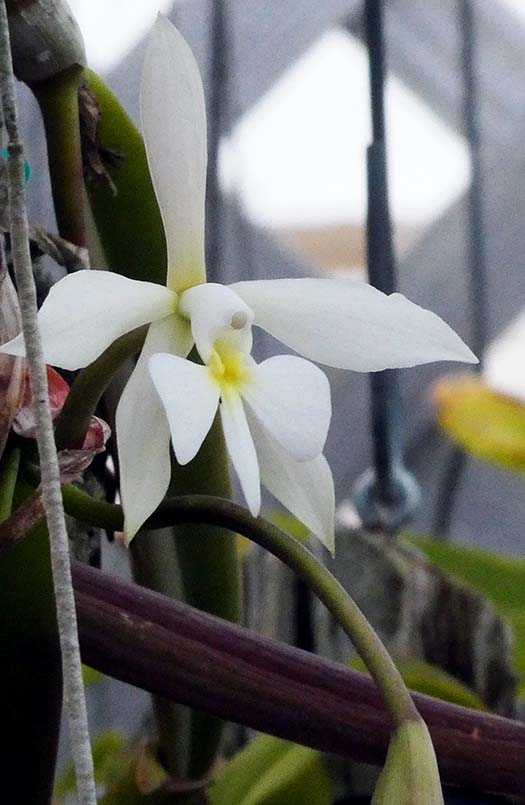 |
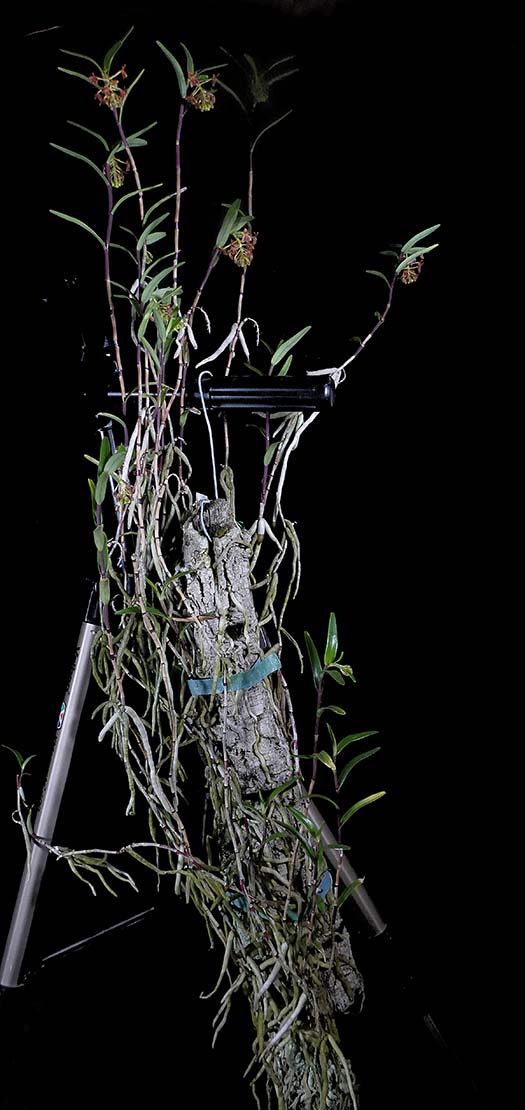
Epidendrum globiflorumNative to Venezuela, Colombia, Ecuador and Peru at elevations 2400-3400 m. It has adapted well to the warmer climate in my back yard, but likely would be harder to grow farther inland. It produces many keikis, all of which can bloom with these cute little flowers. It outgrew its original mount, so I tied to it a larger stick and now it well attached throughout its length. |
 |
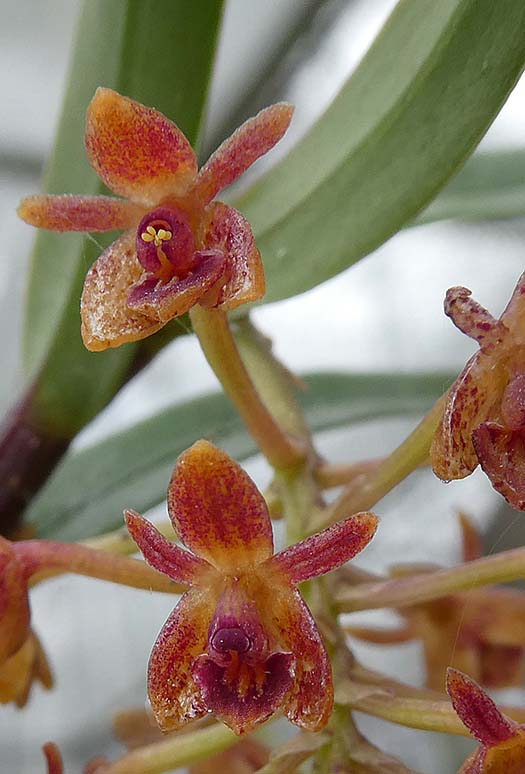 |
|
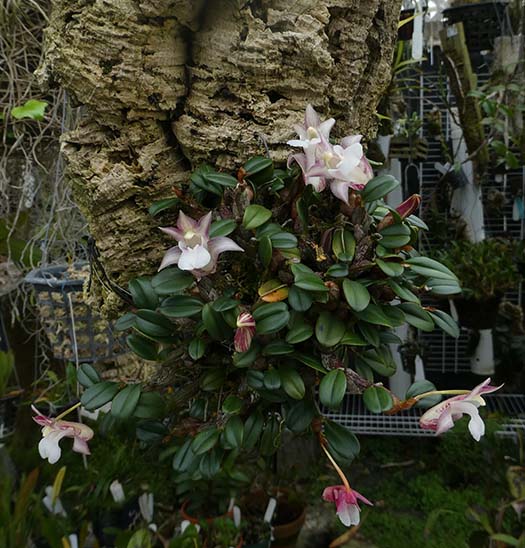 |
|
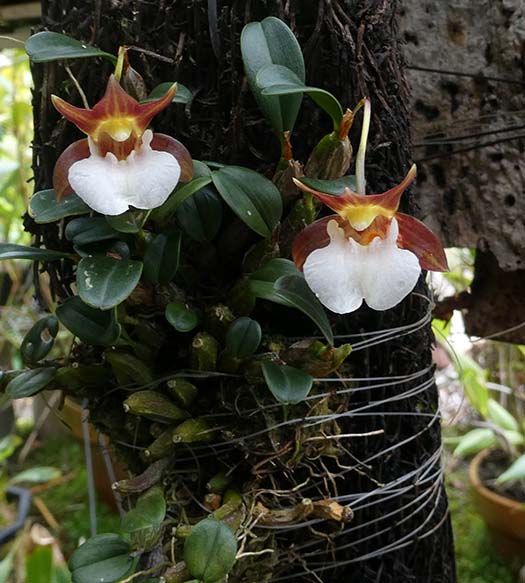 |
 |
Epidendrum (Dendrobium) fargesii, another cultivarThis one is from Yunnan, China. A different color form. |
|

Eulophia speciosaFrom a wide area of eastern and southern Africa. This year, the spike is developing very slowly, just starting to accelerate as the days become a bit brighter and warmer, but still many buds to open. This can bloom for several months, so you may see it again next month. It has lots of new growths (probably due to all the rain it received last winter), which may lead to many more spikes in the future. I will try to keep it a bit drier this winter, to perhaps favor spikes over more new growth. |
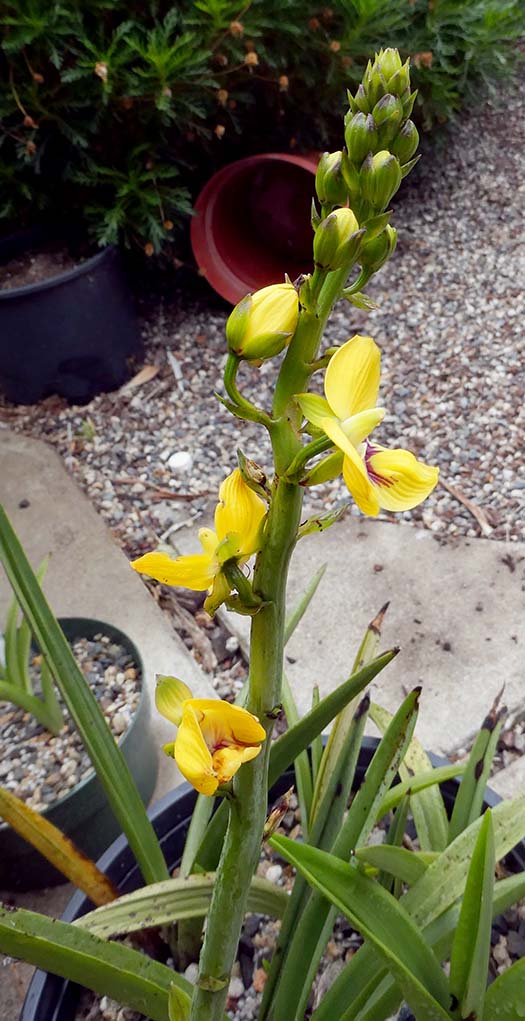 |

Jumellea teretifoliaNative to Madagascar, elevations 1300-2000 m. Many members of the genus come from low elevations and need warmth, but this one is fine outdoors. It is a miniature plant, only about 4 inches tall. It has an excellent flower-to-plant ratio. |
 |

Maxillaria minutaFrom Brazil. It lives up to its diminutive name. Flowers are about 1 cm, 3/8 inch. |
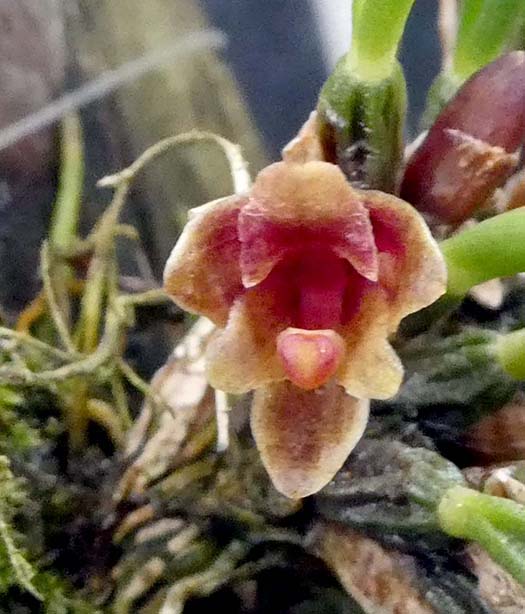 |

Octomeria praestansNative to south and southeast Brazil. A growth can rebloom several times over a year or two. Flowers emerge where the terete leaf joins the narrow pseudobulb. |
|

Maxillaria scalariformisI'm never sure whether this belongs in the "outoors" or "greenhouse" section. I have lost several to crown rot when they were outside for the winter, they do much better for me in the greenhouse in the coldest, wettest months. But they bloom mostly when they're outdoors which is where they spend most of the year. This one bloomed only after it was moved outside. It also blooms in the fall. Andy Phillips grows them successfully outdoors in an exposed area, in a very similar climate so I don't know what might be the difference. It needs to be kept very wet. Native to Panama. |
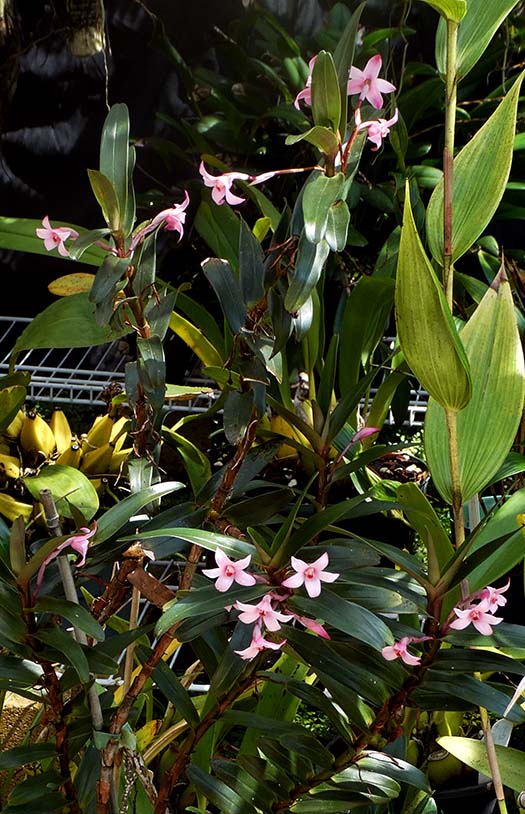 |
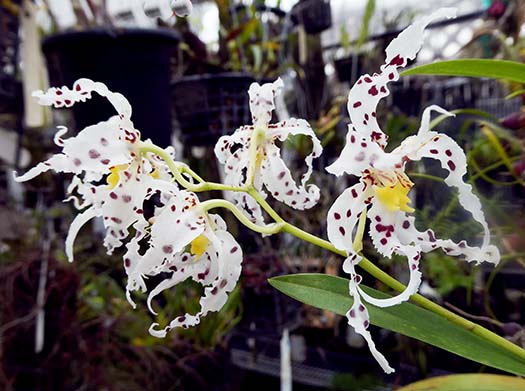
Oncidium (Odontoglossum) naeviumNative to Colombia and Venezuela, elevation 1200-2000 m. Segments are twisty and ruffled. Very rare in the wild. I feel privileged to be able to cultivate it. |
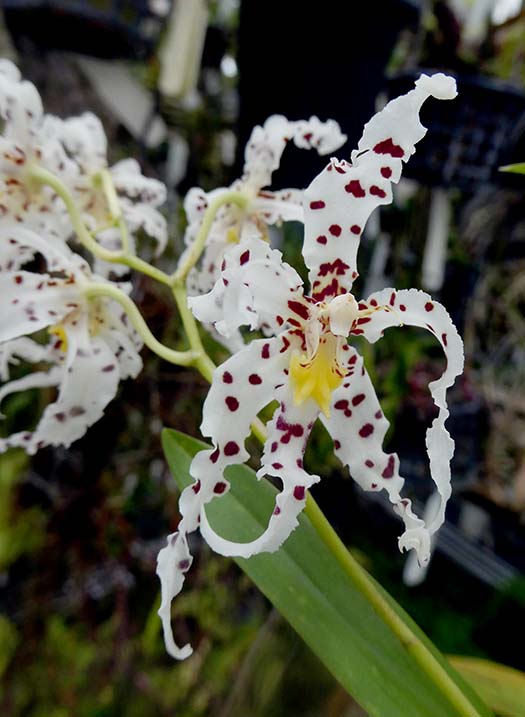 |
 2.jpg) |
 1.jpg) |
Oncidium harrisonianumNative to souteastern Brazil, elevation 1000-1100 m. This floriforous little plant seems to be rather bullet-proof. Leaves are very hard, 1/2 inch flowers are plentiful. It has no moss on the cork slab, is very tolerant of drying out. I have had it for about 15 years. It gets RO water now but grew fine without it. |
|
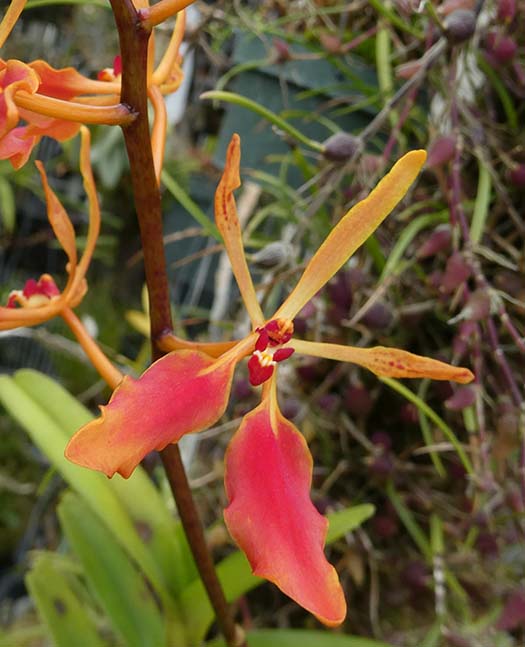
Renanthera pulchellaNative to Mynamar. I can't find any additional information about it. It surely lives up to its name "beautiful". It is a small plant, only about 6 inches tall with spike longer than plant. The fact that it grows well outside does imply that it comes from relatively high elevation. |
 |
In the greenhouse... |
|
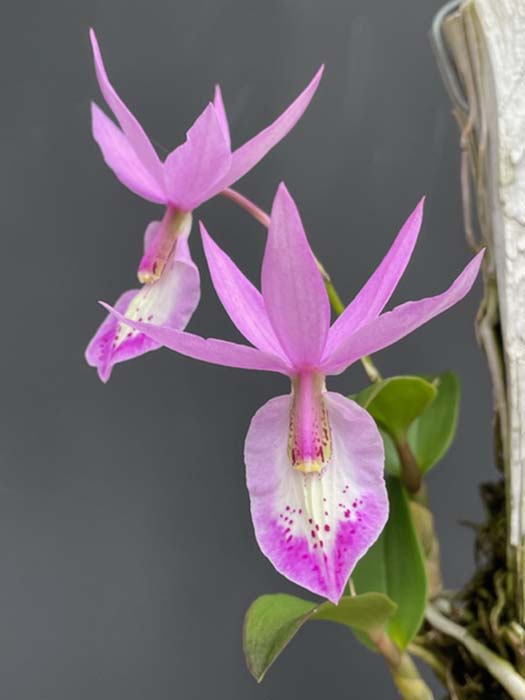
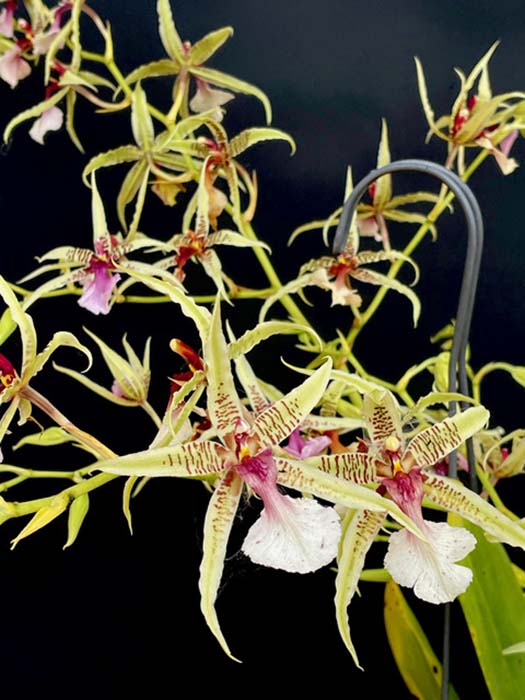

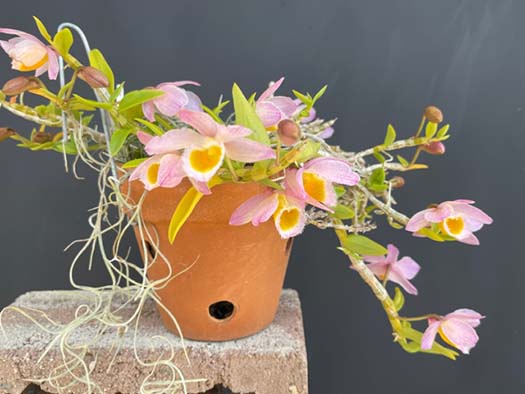


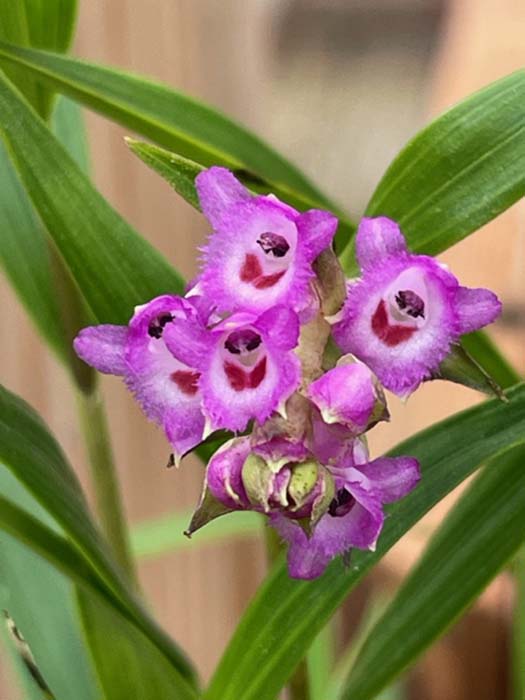
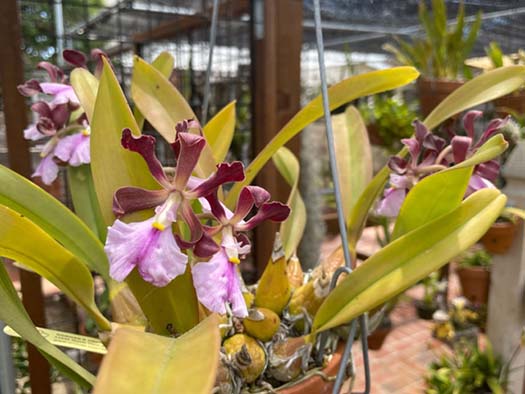
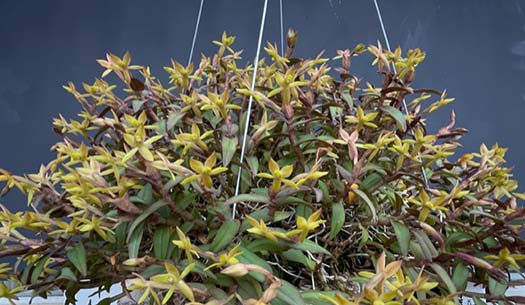
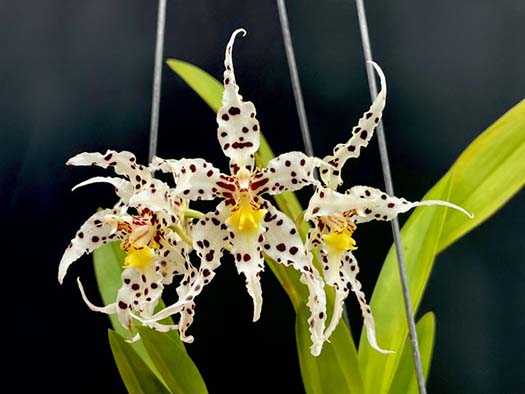
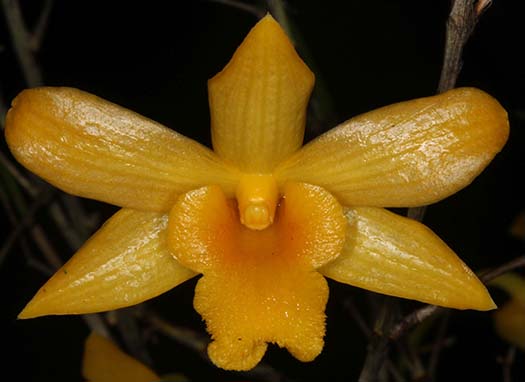
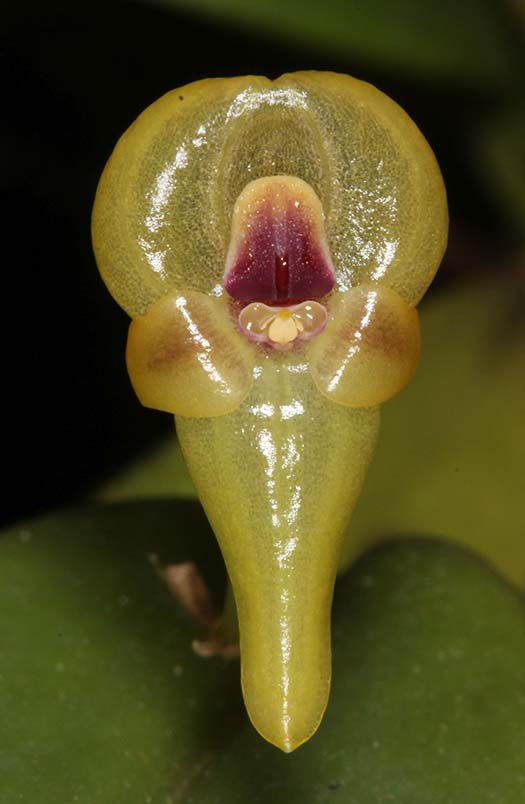

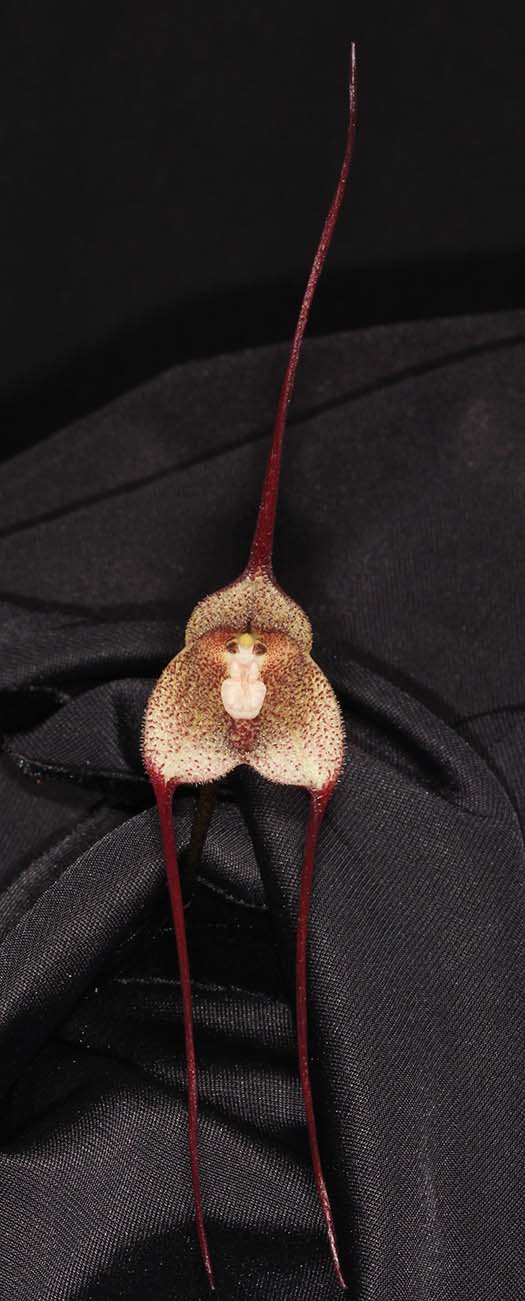
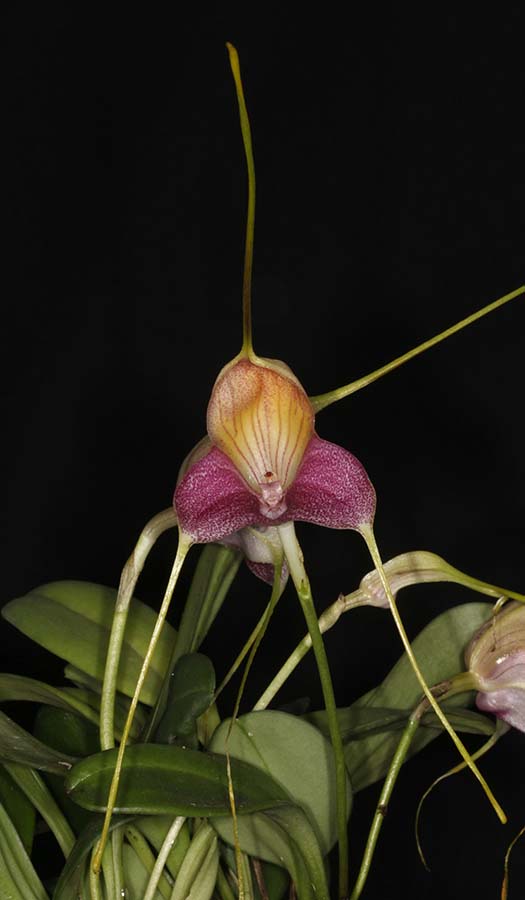
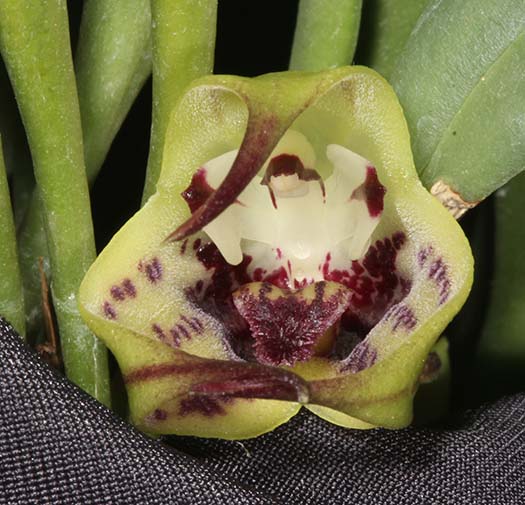
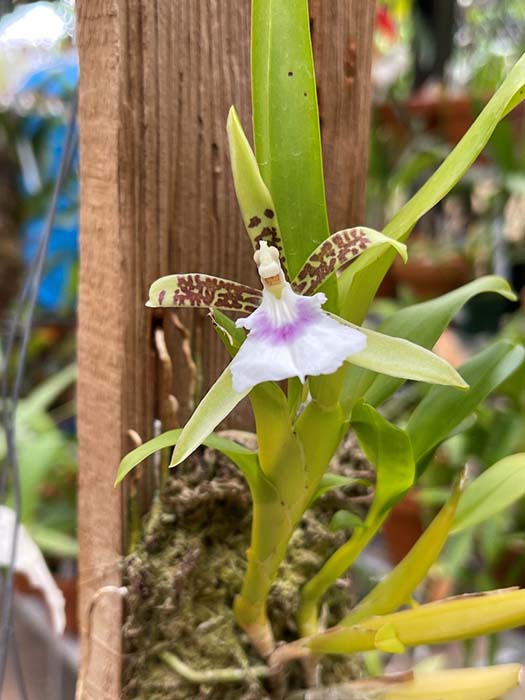

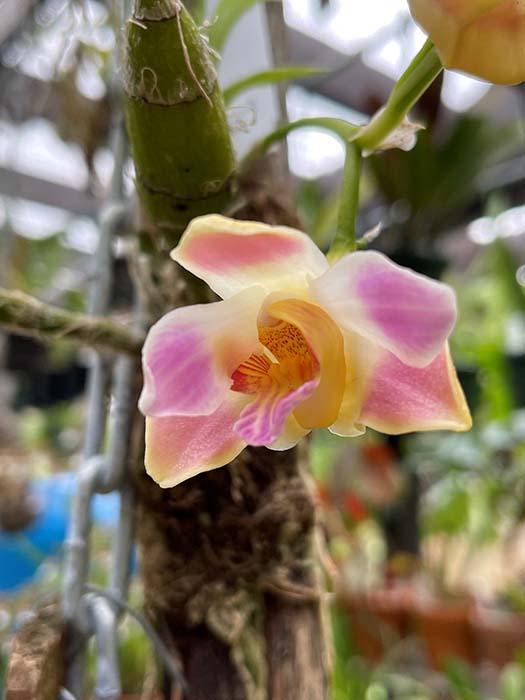



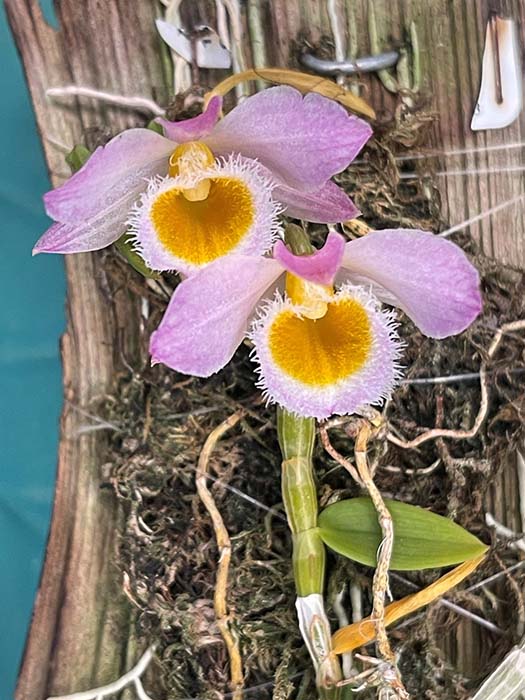

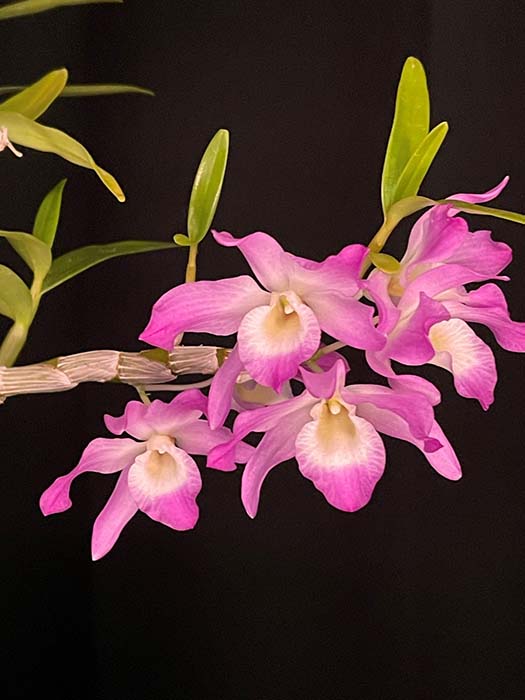
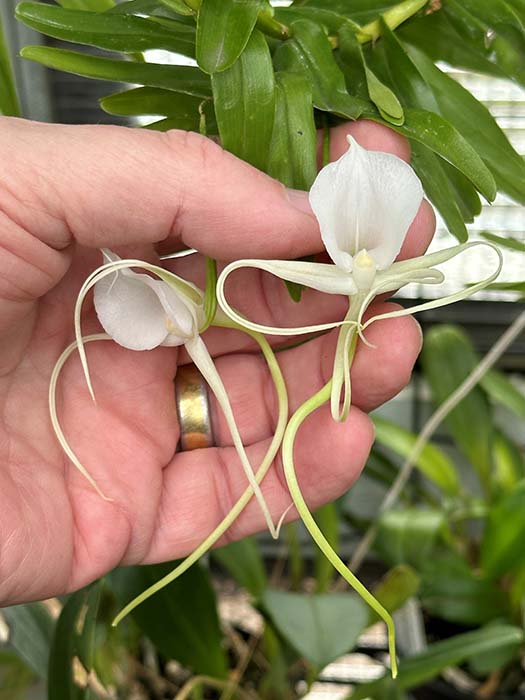


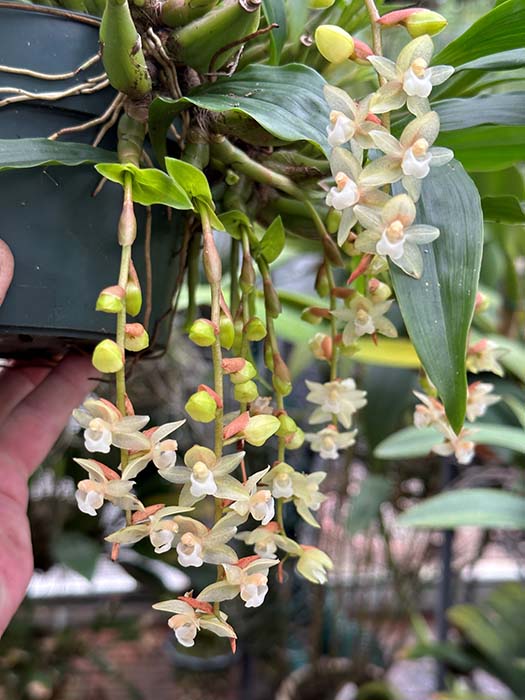
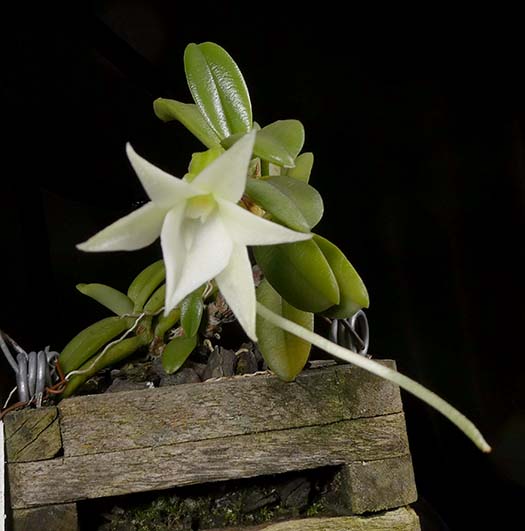
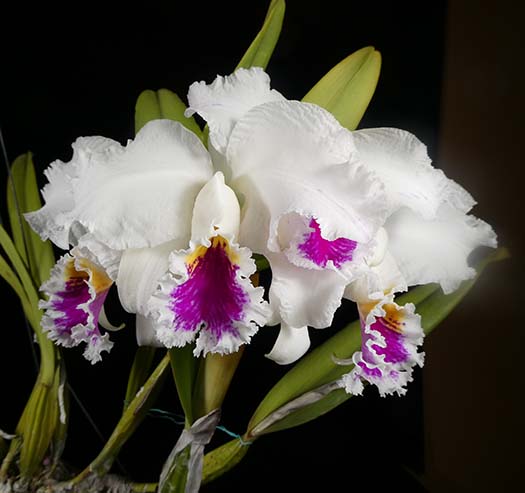
 discolor 1.jpg)

